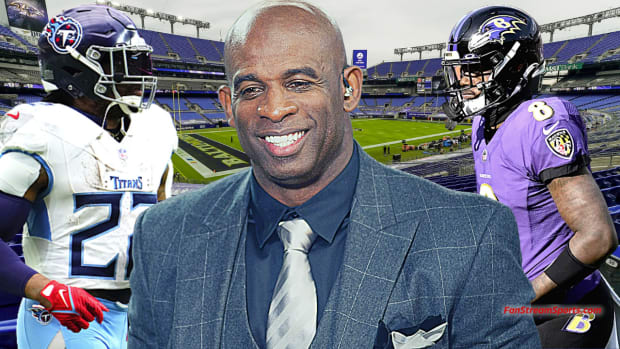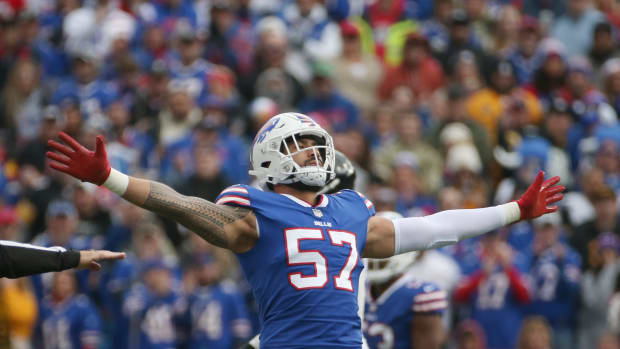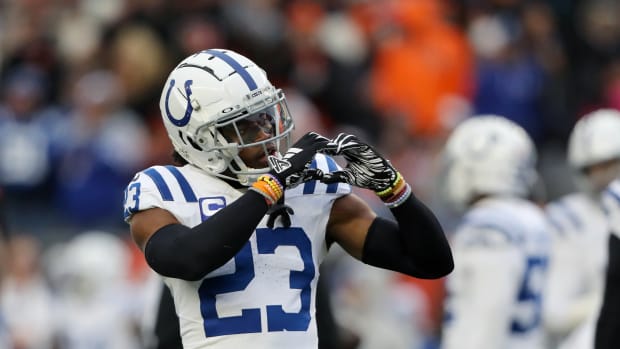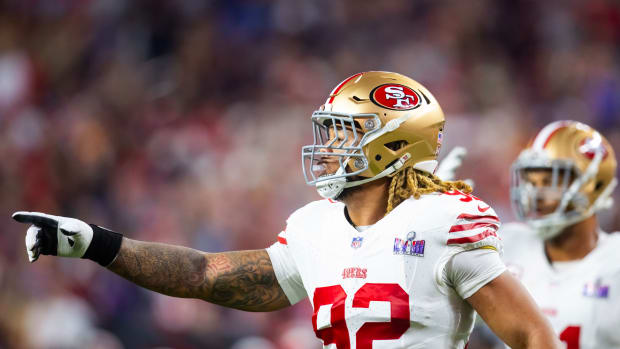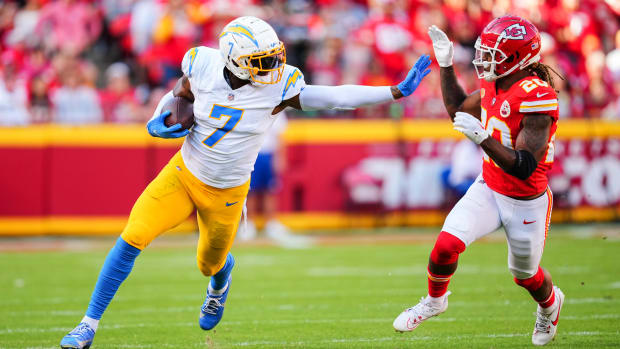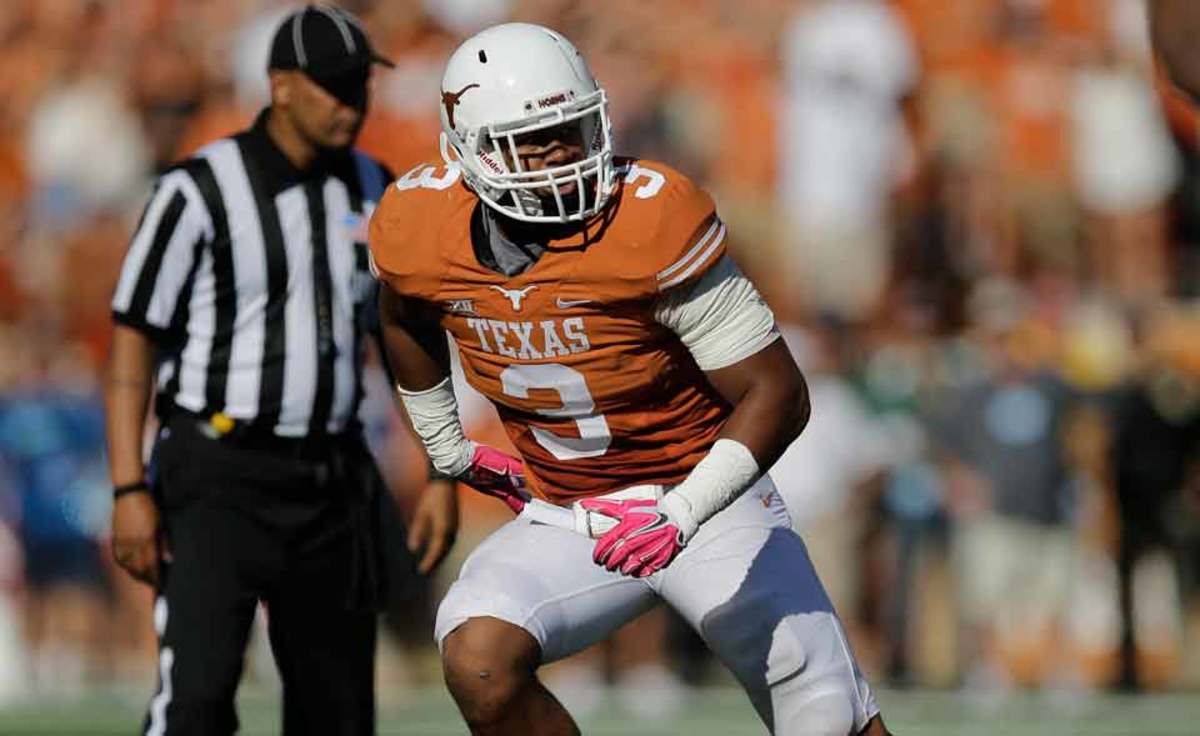
After injury-riddled career at Texas, Jordan Hicks has sights on NFL
Check out more stories from Chat Sports here.
For Jordan Hicks, the narrative is much more complex than one can ascertain with a quick glance. At 6’1”, 236 pounds, the former Texas Longhorns linebacker simply looks the part of a standout defensive star.
While he may come in as a bit undersized by NFL standards, everything about Hicks' physical stature screams discipline and production.
There's nothing about Hicks's looks that could be counted as deceiving in light of his banner senior year in 2014—in which he posted six straight double-digit tackle games, a team-best 147 tackles overall and was named second-team All Big-12.
• Check out complete NFL Draft coverage from SI.com
However, while Hicks' standout campaign may have been a reaffirmation of the talent and tenacity many knew he possessed, this isn't a routine story of an athlete tapping into his potential. This is a guy who came in as the prize of Mack Brown's 2010 recruiting class, only to suffer season-ending injuries in two of his five years in Austin. Hicks gritted it out and nailed the "biggest job interviews" of his life during a whirlwind month training for the Senior Bowl, the NFL Combine, and his Pro Day.
This is the story of an athlete whose body finally gave him the chance to prove himself on the big stage and is set the prove he can have a long NFL career.
*****
Days after Texas Longhorns fell to Arkansas in the Texas Bowl, Hicks was immersed in preparation for his next challenge. "For me, I headed back to Cincinnati … hadn't lived there in five years and it was good to be home, but I got started right away," Hicks says. "I just wanted to get back healthy, but, day one of those workouts, it's full go. For me, the first task at hand was the Senior Bowl. That was the primary focus. Those two weeks were a little bit surreal. You don't feel like a college athlete anymore, but for me, I didn't feel like I was in a new state of mind until things got rolling."
The first thing one notices about Hicks is just how focused he is at the mental side of the game—the planning, the film study, the ability to block out distractions and concentrate on the carefully structured moments that make up every play and series. All of this seems ingrained in the intellect and character of Hicks ever since he was a high school player in southwestern Ohio.
That's what gives Hicks his edge. He has been meticulous with his approach leading up to the 2015 NFL Draft, "It really is the biggest job interview of your life for many reasons. I'm a 22‐year-old college graduate. For me, up to date, I haven't done anything like this."
Projected by most draft analysts following the season to fall somewhere between the fifth round and the undrafted free agent pool, Hicks knew right away that he had to separate himself from the dozens and dozens of other prospects.
Hicks knows his detailed and gruesome injury history is a major red flag hanging over his head. For him, it’s all about proving the doubters wrong.
"It is all about performance," Hicks says. "Football is a performance game. If you don't perform, you're not going to open those eyes you want to open and get the attention you want to get."
*****
2015 NFL Draft All-Underrated Team
Roughly one-third of the athletes who attend the NFL Combine go undrafted. Factor in that only 1.6% of players who make it onto the roster at an FBS football team ever make it to the NFL, and you have an idea of just how big the Combine was to a prospect like Hicks.
"I was in Ohio until a week after the Combine," Hicks says about his training process. "I did my Combine training in Ohio, in Cincinnati, and it was a very specific regimen and a strict diet. Everything was very specific to the Combine and to the Senior Bowl."
Hicks controlled his food intake with the help of Ignition, a Cincinnati-area training facility. He cut fat, put on muscle mass, and refined his body with the help of a training staff well-versed in the science of pre-Combine preparation. With their help, Hicks shaved time off his speed drills, increased his body’s elasticity, and calibrated himself to make dipping and diving through cones a matter of instinct.
"There's about three or four trainers there that delegate their time to us, and do a real job of teaching and making us understand what's to come," Hicks says of Ignition. "Because, like I said earlier, it's a job interview. You've got to do well in the interviews, they've got to know who you are, you've got to communicate yourself well, and you've also got to perform."
Hicks's three days at the Combine in Indy were 20-hour marathons stacked with workouts and a litany of interviews layered on top of each other. "There's two different types of interviews at the Combine, formal and informal," Hicks explains. "The teams get to choose ahead of time to talk to you in the formal interviews. When you do those, it's really your first opportunity to be in front of the head coach, the GM, all of the position coaches. But, at the same time you're in a room sitting in a chair and everybody's surrounding you and asking you questions."
In need of a huge Combine performance to raise his profile, Hicks entered every drill available to him. He posted the second-best time for a linebacker in the 3-cone drill (top-15 overall) and 60-yard shuttle, along with the fourth‐best showing in the 20-yard shuttle.
It was one of the most dominant displays by any Texas linebacker in the history of the Combine—a performance that justified Hicks's month of pure physical and mental sacrifice. "It's huge for me to go there and do good because all I'm trying to do throughout this entire process is open eyes," Hicks says. “Going into the draft and into this whole process, people are talking about me going anywhere from the 5th, 6th, 7th or undrafted. All I'm trying to do is to fight to raise that each outing that I have. That's what this whole thing is about. I'm just fighting and scrapping to get up there.
"I was pretty sure I did well. To me, I did what I set out to accomplish, and that was to open eyes and get people questioning about who I am and to get them intrigued with what they see. My agent and my trainer from Ignition were both with me at the Combine for the three days I was there, and they both texted me to say I was doing a great job. It's rewarding because you put a lot of pressure on yourself going into it to perform well and, when you do, it's a great feeling."
*****
Coming out of Lakota West High in West Chester, Ohio, Hicks seemed destined for greatness. Ranked the No. 4 prospect in the Class of 2010 by ESPN, Hicks was as a Parade All-American in 2009 and won the high school Butkus Award granted to the consensus pick for top linebacker in the nation.
Hicks narrowed his final college list down to Florida, Ohio State and Texas, which was coming off a loss in the BCS National Championship game. Hicks eliminated Florida after coach Urban Meyer retired due to health concerns before unretiring in the offseason.
His final two choices were Ohio State and Texas. As he closed in on a decision, it became clear to recruiters that Hicks wasn't the usual Ohio high school kid that grew up idolizing the Buckeyes. While most recruiting experts assumed Hicks would choose the school 100 miles northeast on I-71 that wasn’t the case. "I grew up moving around a lot," Hicks explains. "I was born in Colorado and moved to South Carolina for five years, Indianapolis for five years, and Ohio for six. So, I'd never been one to catch on with one team or be a true fan of any college team.
"I got used to moving and seeing new things. I think it got embedded in me early. When the time came for me to make a decision to go to college, I think I was ready to see something new, to get a different perspective and continue my growth."
Hicks' whole life has been a series of transitions. So, when he made the trip to Austin to check out the Longhorns' Junior Day event, the uniquely foreign air surrounding the campus and the program grabbed at the core of a kid who has always been enthralled by adventure.
"When you have Coach Brown talking with your mom and selling you on the place, it's pretty hard to say no," Hicks says with a laugh. Brown's knack for selling the Texas Longhorns to kids was well-documented during his time in Austin. It didn't that Jordan's mom was a friend and former employee of then‐Longhorns strength coach Jeff "Mad Dog" Madden.
Hicks committed to Texas in January 2010, heading to Austin as the one of the top-ranked signees in a recruiting haul, which included six players from the top 20 of the 2010 ESPN300 rankings.
But things didn’t get off to a great start for Hicks in Austin.
*****
Four different defensive coordinators in five years. Two head coaches (Brown and Charlie Strong) utilizing their own sets of philosophies, tendencies and motivational tactics. A restless fan base that had watched a program fall from the peak of power.
These challenges alone were tough for a young player who had come into Austin expecting one thing before being sideswiped by a never-ending procession of staff changes and general disorder. However, Hicks had grown up around transition. He knew change and how to deal with it. He still had the physical tools and the mental processing skills to get his work done, and he did so with a solid true-sophomore season (50 total tackles, 3.5 tackles for a loss, 1 sack) that seemed to portend big things ahead.
But as is the case with so many players, injuries took their toll. "My first injury was against Ole Miss my junior year," Hicks recalls. "My groin had been aggravating me a bit, but I went out there and played and didn't think much of it. I go to make a tackle, and all of my weight falls on my groin and I just hear a pop. My adductor in my groin had torn off the bone.
"I had to sit out for a few games, and I tried to come back for the Oklahoma game which I think was about three weeks after. Ultimately, I re‐aggravated it and had to sit out the entire season."
The first major injury of his athletic career, Hicks was forced to tighten his focus and tailor his approach to turn strife into future success. He threw himself into his rehabilitation process, desperate to prove himself worthy of the top billing he had been saddled with coming out of high school.
Everything seemed to be in place for a big senior season in 2013, as he averaged more 10 tackles a game over the first three games. Then his body gave out for a second time.
"I came back that fourth game against Kansas State and I end up tearing my Achilles in the third quarter," Hicks says. "For me, that was the true heartbreaker. It kind of defined my career a little bit, being labeled as somebody who is injury prone and whose health is always questioned. Compared to the first injury, it was a lot worse. I wasn't sure what I did wrong."
Hicks was gutted. One injury could be written off as a freak physical breakdown. Two season-ending injuries threatened his NFL job prospects and left him grasping for answers. "To come out there and have such a serious injury, it makes you question why," Hicks says with calculated optimism.
"For me, it was all about control. It was something that I couldn't control; that was out of my hands. I wouldn't have been able to do it without the support system I had (at Texas). I lived in a house with five other players and they made sure I was included in everything. The support system I had did an amazing job keeping my head on straight and making sure I could get through it."
Hicks did indeed get through it, and when his body was fully healed prior to his granted fifth year of eligibility.
******
Ask the offenses and offensive coordinators of the Big 12 whether Jordan Hicks was healthy or not in 2014. They'll probably shake their heads before offering a grunt and mumbling a begrudging "yes." Hicks led a Texas defense that held the Longhorns afloat while their offense struggled to work through its kinks. He ripped through blocks fluidly, wrapped up ball carriers with fundamental glee, and owned the turf for a vast majority of the team’s regular‐season contests. It was an essential showcase for a player who had one last shot to prove himself as worthy of a jump to the next level.
"With all the expectations from my freshman, sophomore, junior, and senior years, everything I had tried to do came down to this one year," Hicks says of his fifth year in Austin. "Everything I had to prove to scouts, to myself, to my family, to my team, to my coaches ... everything came down to this one final year. Thank goodness I had Coach Strong and my teammates around me, and I was able to put it all together and have a really good senior season that I will always remember."
Hicks admits to waging a prolonged battle with insecurity leading up to his fifth year, with echoes of fans' vocal criticisms of his dependability and worries about scouts' perceived indifference swirling around his head. "A lot of that makes you question about whether you truly are dependable," Hicks admits. "I've always held myself to a higher standard and tried to be as dependable and accountable as possible, but it's really, really tough when you can't do that physically."
As tough as it was, Hicks survived and flourished. Having already applied for a sixth year as a medical redshirt, Hicks didn't wait for an answer before declaring for the NFL Draft. It was his time.
******
Following the second of his season-ending injuries, Hicks became the star that he always knew he could be in year five, and he had earned the perspective (tempered by a string of hardships) to step back and enjoy it in the moment.
"Number one, I appreciated it more," Hicks says of his final year at Texas. "After going through everything I had been through, it helped me play with emotion, it helped me play with a sense of appreciation, and really just to let go of all this pressure I put on myself.
"Whatever happens, happens. If I get injured again, I'm going to be fine. I figured out who I was and what I truly value. I understand football is a game that could last a long time or it could end on a freak play. If I do great, that's awesome and it's everything I ever wanted. If I do bad, I've had the greatest experience of my life at the University of Texas and I gave it everything I could."
The sense of perspective Hicks exhibits when he looks back on the rise, fall, and second rise of his football career is the same perspective that he put to good use during the slog of the pre‐draft process.
While he declined to mention which teams he's visited in the days leading up to the draft, he did reveal that he's met with four in person, and that all of them have expressed concerns about the injuries that cost him two years of his collegiate career.
"That's one of the huge concerns with me, and I understand that," Hicks says. "That's why this last year was so big for me. They want to know what I think the reasoning behind it was, what I did to make sure it didn't happen again. Whether or not they can depend on me. Ultimately, they're investing in a player to perform, and if you're injured you can't possibly perform."
Hicks has developed an ingrained “prove it” attitude emblematic of a unique, perhaps unfair set of life lessons.
So, despite spending his recent days under the microscopes of multi-million dollar franchises, battling critiques saying he’s too rigid or too prone to "playing through a straw" (being unwilling to deviate from formational assignments), Hicks isn't affected—at least not outwardly. He has surrounded himself with the right people, done the right things, and has learned to draw upon his setbacks for inspiration. He's been through the woods and he’s a better man for it.
"Luke Kuechly is a guy that I always try to watch and mimic my game after. He has great instincts and an understanding of the game," Hicks says.
Kuechly is the intellectual's linebacker, using equal parts cunning and aggression to outthink and outwork his competition. That's what Hicks is trying to be and that's what Hicks seems intent on emulating.
With two comeback stories seemingly lifted out of Hollywood to his credit, he very well could be the next Luke Kuechly. Perhaps someday a few years down the road, prospective NFL linebackers pattern their games after Hicks.
Check out more stories from Chat Sports here.
































